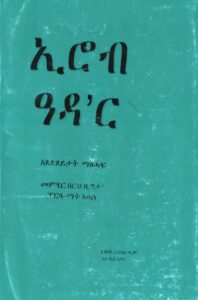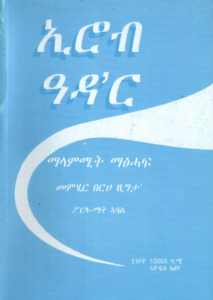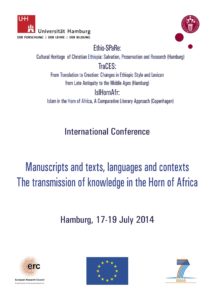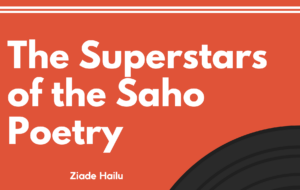Poems
ኢሮብ ዓዳ’ር [Irob ʿAdar “Irob poetry”] (1st vol.) (2004 Ethiopian Calendar = 2011)
by Berhe Zigta
 A collection of 812 Saho poems (ʿadar), divided in four sections:
A collection of 812 Saho poems (ʿadar), divided in four sections:
1. 1-366 ቡክናይቲ-ዓ’ረህ ዓዳ’ር [Buknayti care cadar “Poems of the Buknayti ʿare”]
2. 1-255 ሓ~ሳባልላት ዓዳር [Xaasaballat cadar “Poems of the Ḥasaballa”]
3. 1- 88 ኣድጋዲ-ዓ’ረህ ዓዳ’ር [Adgadi care cadar “Poems of the Adgadi ʿare”]
4. 1-103 ሓዲ-ዲኪ’ህ ዓዳ’ር [Xadi dikihʿadar “Poems of the Ḥadi dik”]
Self-published in Addis Abeba.
ኢሮብ ዓዳ’ር [Irob ʿAdar “Irob poetry”] (2nd vol.) (2005 Ethiopian Calendar = 2012)
by Berhe Zigta
 A collection of 841 Saho poems (ʿadar), divided in four sections:
A collection of 841 Saho poems (ʿadar), divided in four sections:
1. 1-387 ቡክናይቲ-ዓ’ረህ ዓዳ’ር [Buknayti care cadar “Poems of the Buknayti ʿare”]
2. 1-210 ሓ~ሳባልላት ዓዳር [Xaasaballat cadar “Poems of the Ḥasaballa”]
3. 1- 68 ኣድጋዲ-ዓ’ረህ ዓዳ’ር [Adgadi care cadar “Poems of the Adgadi ʿare”]
4. 1-176 ሓዲ-ዲኪ’ህ ዓዳ’ር [Xadi dikihʿadar “Poems of the Ḥadi dik”]
Self-published in Addis Abeba.
Saho Islamic poetry and other literary genres in Ajami script (2014)
by Ahmedsaad Mohammed Omer, Giorgio Banti and Moreno Vergari

 A paper presented at the conference Manuscripts and texts, languages and contexts. The transmission of knowledge in the Horn of Africa – University of Hamburg, 19 July 2014.
A paper presented at the conference Manuscripts and texts, languages and contexts. The transmission of knowledge in the Horn of Africa – University of Hamburg, 19 July 2014.
Saho is an East Cushitic language spoken in Eritrea and in northern Ethiopia. Its closest sister language is ʿAfar. Most of the Eritrean Saho are Muslims, and Islamic hymns, called nazme, are sung in Saho by sheikhs and their followers during the mawlid and other religious ceremonies. They alternate with Arabic hymns read, e.g., from the booklet Mawlidu ’l-Nabī by Muḥammad ʿUṯmān al-Mīrġanī. They are generally associated with popular Sufi Islam and the Ḫatmīyya order.
It is unknown when Saho nazme composing and singing began, because they are mostly remembered anonymously. As far as the present authors know, there are no printed collections of Saho nazme, but only occasional instances of sheikhs recording them in ajami Arabic script. One example of nazme will be discussed in the presentation. It was elicited by the authors in Irhaafalo (Eritrea) in 2010 from its author, Sheekh Soliiman Ismaacil Maxammad, who also provided a manuscript copy of it in ajami. Other examples of Saho literary texts written in ajami script and read by the Saho diaspora in the UK will also be discussed.
Source: https://www.academia.edu/7777904/Saho_islamic_poetry_and_other_literary_genres_in_ajami_script
The Superstars of Saho poetry. The Irob ‘Adar: Literary criticism (2020)
by Ziade Haile
Source: https://zinotes.wixsite.com/home/post/the-superstars-of-the-saho-poetry
See also: The nazme: A genre of religious poetry of the Eritrean Saho
See also: Back to the Village: Integrating Folk Media into Rurak Food Security Communication in Ethiopia, in http://www.sahoarchive.org/ethno-anthropology-and-culture/
See also: ስን ቃል ህዝቢ ኢሮብ [Sǝnä-Qal Hǝzbi Irob “Terminology of the Irob people”] (2001 Ethiopian Calendar = 2008) in http://www.sahoarchive.org/ethno-anthropology-and-culture/
See also the Other texts section



